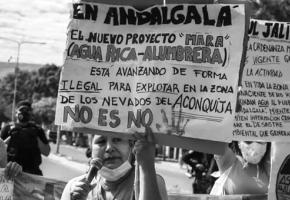The legal battle of Ecuadorians affected by the oil spills began in 1993, when a coalition of affected residents of villages and five indigenous groups were brought together by a newly qualified Ecuadorian lawyer, Luis Yanza, soon joined by oil worker Pablo Fajardo, one of the victims, who started a legal career to pursue the case. Yanza and Fajardo worked with a team of US lawyers, including Steve Donziger, to bring a class action suit against Texaco in a New York district court, near the company’s headquarters.
After a dismissal followed by an appeal, the New York judge in the case invoked forum non conveniens — inappropriate jurisdiction – and moved the proceedings back to Ecuador in 2002. The company was probably pleased: they calculated that they had much less to fear from judges in a relatively weak state where both the judiciary and the government might be reluctant to confront a large US corporation. Even if the judgement went against them, it was highly unlikely that it could be enforced. So far, they have been proved right
In May 2003, the 30,000 affected plaintiffs, represented by Yanza and Fajardo, filed a lawsuit in Ecuador against Chevron, demanding removal of all formation (drilling waste) waters, debris, equipment, remediation of contaminated water bodies and lands, recuperation of fauna, flora and aqueous life, monitoring and improvement of the health of the inhabitants. Details of the suit were cited by the Goldman Prize organization in awarding their annual environmental prize for 2008 to Yanza and Fajardo.
After 45 field inspections and 200,000 pages of trial evidence citing 62,000 laboratory analyses, the court of Sucumbíos ordered Chevron Corporation to pay damages of US$18 billion for remediation of waters, soils and ecosystems. This was reduced to US$9.5 billion by the Ecuadorian Supreme Court in 2011.
Chevron fights back
The company (at that point still Texaco) made its first move against the claimants in 1993 by initiating a counter-claim to ensure that any trial would be delayed. The effect of the delay made it almost impossible to determine how much pollution was caused by Texaco and how much by subsequent oil waste dumps established by PetroEcuador. Texaco had ceased operations in Ecuador in 1992, after which it is estimated that PetroEcuador was responsible for 801 oil spills between 1990 and 2004, amounting to 1.9 million gallons, with 420,000 gallons spilled into the Coca River in May 2013 alone. This has certainly complicated the case.
In the 2003 case and subsequently, Chevron’s lawyers summoned a vast range of arguments in their defence, some of which may have been justified, at least on technical grounds. Yet the company had an advantage against the Ecuadorian plaintiffs from the start: they had virtually unlimited resources at their disposal to finance their defence and counter-claim. Following the Ecuadorian Supreme Court decision in 2011 (upholding the judgement, but reducing the fine) Chevron decided to change jurisdictions once more. They filed a lawsuit against Ecuador in New York in 2011, and took the case to the International Court at The Hague the same year. An arbitration tribunal at the Hague – where the parties themselves select the arbitrators – ruled against the government of Ecuador in favour of Chevron with regard to compensation claimed by the latter.
The Ecuadorian lawyers’ attempt at a class-action suit in New York finally backfired in 2014, when Judge Lewis Kaplan, having first refused to take on the Ecuadorians’ case against Chevron, accepted Chevron’s counter-case against their US lawyer, Steve Donziger, whom they accused of racketeering under the Racketeer Influenced and Corrupt Organizations Act (RICO).

Steve Donziger New York 16 August 2018. Photo: Linda Etchart
This counter-case was then appealed to the New York Supreme Court’s Appellate Division which ruled against Donziger in July 2018, when it accepted Judge Kaplan’s findings that Donziger and others had ‘submitted fraudulent evidence’, ‘coerced a judge’, ‘paid a Colorado consulting firm secretly to ghost-write the expert’s report’, and made a ‘misrepresentation to US courts’. The Court concurred with Judge Kaplan’s conclusion with regard to ‘uncontroverted evidence of serious professional misconduct which immediately threatens the public interest’.
Chevron’s own propaganda onslaught against Donziger and the Ecuadorian litigants, from the slick Amazon Post website, which admits to being ‘maintained by Chevron to express the company’s views and opinions on a fraudulent lawsuit against the company in Ecuador’.
The ‘public interest’ in this case appears to be Chevron’s interest. When Donziger sought to prosecute the case in countries where Chevron continued to hold assets which could be seized in the event of a court ruling against them, Judge Kaplan attempted to declare a worldwide injunction against the Ecuadorians’ taking the case to another jurisdiction on the grounds that by this Chevron would be ‘threatened with immediate and irreparable injury’. The injunction was not upheld by the US courts and was later withdrawn.
Dividing the plaintiffs
Steve Donziger has continued to pursue the case against Chevron in the Canadian courts, but meanwhile has lost the support of some of the Ecuadorian lawyers from the original class action suits in New York and in Ecuador, so that he no longer works alongside Pablo Fajardo. According to Julio Prieto, another Ecuadorian lawyer who was part of Donziger’s team, Fajardo now represents the Union of People Affected by Texaco (UDAPT), which is separate from Donziger’s Amazon Defense Coalition. There appears to be friction between the two groups, as the UDAPT claims to be the sole organization representing the indigenous peoples and farmers who started the lawsuit against Chevron.

Huaorani indigenous people. Photo: Julio Etchart: www.julioetchart.com
This is further complicated by the 2014 amici curiae (informational brief filed with the court by someone who is not party to the case) submitted to the New York court by Professor Kimerling2, who stated that Donziger did not represent the Huaorani people affected, as they were not consulted during the process of the negotiations around the litigation: ‘Donziger secretly wrested ownership and control of the claims and interests of the Proposed Huaorani Intervenors and other members of the Huaorani people in the Lago Agrio Litigation and ceded that ownership and control to his cohort ADF [Amazon Defense Coalition]… Donziger engaged in conduct that has dissipated the claims of … the Huaorani people for the injuries they suffered from Chevron’s oil extraction activities in their lands and their interest in the Lago Agrio judgment’2.
Kimerling was involved in another separate lawsuit, filed against Chevron by thirty-one Kichwa and Huaorani communities who formed an alliance called Makarik Nihua in 2003. The importance of this case is that it targets the Ecuadorian government and PetroEcuador, as well as Chevron. And, in this case, the plaintiffs are only the indigenous communities, and invokes indigenous rights and legal protections which would not have been available to non-indigenous plaintiffs.
Ninety plaintiffs took their case to the Superior Court of Justice in the Amazonian town of Tena, capital of Napo province, claiming ‘environmental remedies’ from both Texaco/Chevron and PetroEcuador for injuries they had suffered as a result of oil extraction. They argued that the Ecuadorian government and PetroEcuador had violated their indigenous rights, and that Chevron, the Ecuadorian government, PetroEcuador and the US government should accept responsibility for the contamination and contribute to reparations. The court in Tena refused to open the case.
There are at least five overlapping and competing narratives in the case: that of the New York court in supporting Chevron’s case and their legal suit against Donziger; that of various groups associated with and comprised of affected peoples, including the original Ecuadorian lawyers such as Pablo Fajardo, who distanced himself from Donziger; that of Professor Kimerling, who supports the case against Chevron yet is critical of Donziger; and that of Chevron itself and the mainstream press which endorses their case against the Ecuadorians. Last, but not least, Steve Donziger has his own media campaign, having had the backing of environmental NGOs from the initiation of the class-action suit, not least from Amazonwatch and Greenpeace. Donziger won support from some of the press and celebrity campaigners, and through Joe Berlinger’s 2009 film Crude, which presented a convincing case against Chevron.
Unfortunately for Donziger, the film that won him international recognition for his courage and his achievements, also contributed to his undoing, as Chevron’s lawyers obtained a ruling by New York Judge Kaplan to admit into evidence some compromising out-takes from Crude in which Donziger decried corruption in the Ecuadorian courts.
Target the lawyer
If, as Chevron repeatedly argued, it could not be held liable for the activities of Texaco, then the herculean efforts expended by its lawyers to challenge every detail of the suit against them are surprising. The company employed 60 legal firms and 2,000 lawyers to pursue the case, which has cost them up to US$2 billion, according to Aaron Marr in the Huffington Post.
The company went on to file a $33 million claim against Steve Donziger himself, apparently calculated on the basis of their payments to lawyers at Gibson, Dunn & Crutcher. The lead lawyer, Randy Mastro, was charging Chevron US$1,140 per hour in fees, and the firm billed Chevron for 36,837 hours in 2014. Chevron’s personal claim against Donziger was almost as much as the US$40 million that Texaco paid for the woefully inadequate clean-up operation in the Amazon.
Chevron’s lawsuit against Donziger and his legal team5 is an example of a SLAPP (a Strategic Lawsuit Against Public Participation) the purpose of which is not necessarily to win in court, but designed to ‘intimidate, harass, demonize, and bankrupt the weaker opponent’, according to Rex Weyler of Greenpeace, who in May 2018 described Chevron’s SLAPP suit as ‘perhaps the most vindictive SLAPP in history’6. Chevron’s SLAPP tactics now include issuing subpoenas in the US for emails from 57 of the Ecuadorians’ supporters, including a Boston hedge fund manager and from Rex Wexler himself.
The legal strategies employed by Chevron against claimants in class-action suits are standard practice in the corporate world. International and national government and non-government human rights organizations have expressed concern in particular at prosecutions of environment defenders, describing them as ‘judicial harassment and criminalization’ — in the words of Michel Forst, Special Rapporteur on the Situation of Human Rights Defenders, in his report to the United Nations General Assembly on 19 July 2017.
In his UN Human Rights Council report1, Forst describes the way in which the alleged misdeeds of human rights lawyers such as Donziger are cited to draw attention away from the severity of the violation of human rights and damage to the environment resulting from corporate negligence. He goes on to say ‘defenders are suffering attacks by business actors overpowering and silencing them, which exerts a chilling effect on their work.’
In the Ecuador case, Chevron employed harassment and bullying tactics, giving instructions to publicists to engage in a demonization of Donziger, as reported by Aaron Marr in the Huffington Post in 2017. Attacks on Donziger in the press were reinforced by a vilification campaign against him in US law journals, such as that by Emily Seiderman in the Fordham Law Journal in 2013. Siederman4 accused Donziger of wrapping himself in a ‘cloak of moral justice’. Her argument was that Chevron would suffer ‘irreparable harm’, if it were to lose the case. She described the case as an example of ‘abusive enforcement proceedings’ against Chevron.
Professor Michael Krauss of George Mason University has also been outspoken in his attacks on Donziger and in defence of Chevron in Forbes magazine3. On 24 October 2017 Krauss described the case as ‘Ecuador’s corrupt efforts to extort almost $10 billion from Chevron Corp for pollution damages allegedly [emphasis added] caused by Texaco’ and he vowed that ‘until all enforcement suits are dismissed and all unethical lawyers punished, I will continue to report.’
Steven Donziger may or may not be guilty of legal malpractice, as found by New York judge Kaplan, and his conduct may or may not have merited his debarment (the finding that he was guilty of ‘racketeering’ has provoked hilarity among New York lawyers) but this is far from conferring a moral victory on Chevron. The evidence that he approved a payment of US$500,000 to Ecuadorian Judge Zambrano to rule against Chevron, appears less than convincing.
Until hell freezes over
Journalist Steve Mufson commented in the Washington Post in 2013 that the litigation had taken the case ‘straight down the rabbit hole: litigation about lawyers’ conduct vis-a-vis litigation that is itself about lawyers’ conduct vis-a-vis yet another litigation.’
After such vast sums have been spent on Chevron’s legal case, and more than 20 years of litigation, the reams of documentation becomes challenging for lawyers, let alone the lay reader. What cannot be disputed is the famous quote by a Chevron spokesman in 2009 in an interview with the Global Post: ‘We’re going to fight this until hell freezes over … And then we’ll fight it out on the ice.’
In his summing up in the case against Donziger, Judge Kaplan said, ‘The saga of the Lago Agrio case is sad. It is distressing that the course of justice was perverted. The LAPs [Ecuadorian plaintiffs] received the zealous representation they wanted, but it is sad that it was not always characterized by honor and honesty as well. It is troubling that … what happened here probably means that we’ll never know whether or not there was a case to be made against Chevron.’
Kaplan appears to consider that that is the end of the story. But why should the disbarment of one attorney mean the end of this case or others related to it? It should be the beginning of a rethink by all oil companies, state and private, still operating in region; and by governments. The fact that Donziger lost the case does not mean that Texaco was not responsible for oil contamination of the environment; but it does mean that prosecuting Chevron for that contamination is unlikely to succeed.
This case highlights the extreme difficulty of framing and targeting legal action. In Lago Agrio, at least four parties were responsible at different times for actions or negligence which contributed to the environmental disaster: Texaco, Chevron, PetroEcuador and the Ecuadorian government. Taking on all of them at once might make historical and evidential sense. But it would exponentially increase the opportunities for evasions, counter-claims and shuffling jurisdictions. In the last resort the plaintiffs might litigate in the InterAmerican Court of Human Rights, in which case they would be prosecuting their own government.
What the entire Lago Agrio experience demonstrates is that oil companies can act with impunity in drilling for oil in areas with fragile ecosystems; that inadequate Environmental Impact Assessments (EIAs) will continue to be conducted as governments have an interest in rushing them through; that companies will ensure that they have indemnity agreements absolving them from responsibility for environmental damage; and that when charges are made, they can go ‘forum-shopping’ to ensure a hearing in a country that is favourably disposed towards their corporate interest. Finally, if all else fails, they can turn on the plaintiff’s lawyers, accusing them of dishonesty, corruption or even racketeering.
Donziger’s fate illustrates the challenges facing civil society, governmental and inter-governmental institutions in their attempts to establish safeguards to protect the environment. Indigenous environment-defenders remain unsupported except by non-governmental organizations and myriad uncoordinated UN and regional agencies that do not have the power to implement sanctions against environmental polluters.
Meanwhile, back in the Ecuadorian Amazon, oil companies, local and foreign, continue to extract oil, with concessions being granted to various consortia, state and private, over the entire area. Oil development remains the primary engine of deforestation and dislocation of indigenous peoples.
The case reminds us of the vulnerability of environmental defenders when pitting themselves against corporate interests and the urgent need to find other means of forcing corporations to halt their operations in environmentally sensitive areas, to cease deforestation, and to engage in alternative forms of energy creation that do not destroy the health and wellbeing of peoples, their cultures and the environment.
Linda Etchart is a lecturer in Human Geography at Kingston University. She is author of the chapter ‘Indigenous Peoples and the Rights of Nature’ in LAB’s new book Voices of Latin America (forthcoming, Jan 2019). This article was originally published by Latin American Bureau. For more great articles visit www.lab.org

















